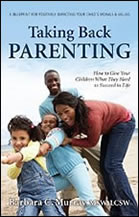Article first published as Taking Back Parenting by Barbara C. Murray on Blogcritics.
June 12, 2014
Taking Back Parenting:
How to Give Your Children What They Need to Succeed in Life
Barbara C. Murray
Aviva Publishing (2014)
ISBN: 9781938686931
New Book Puts Parents Back in Control with Confidence and Common Sense
 Any parent, or even adults who spend time around children, will do well to read Barbara C. Murray’s new book Taking Back Parenting. In concise and thoughtful discussions, Barbara covers a wide range of topics that parents need to be concerned about with their children from how to teach and communicate with your children to creating a safe environment for them, how to maintain your relationship with your spouse, and even how to discuss difficult topics with your children such as sexuality and pornography.
Any parent, or even adults who spend time around children, will do well to read Barbara C. Murray’s new book Taking Back Parenting. In concise and thoughtful discussions, Barbara covers a wide range of topics that parents need to be concerned about with their children from how to teach and communicate with your children to creating a safe environment for them, how to maintain your relationship with your spouse, and even how to discuss difficult topics with your children such as sexuality and pornography.
From the first page of this book, I realized Barbara was a real parent. Yes, she has a degree and is a clinical social worker, but she is obviously a parent first, and almost every example in the book that she provides is based upon her own parenting experience. Other examples are based on her experiences with helping clients better parent their own children and what worked or didn’t work for them.
What I loved most about this book is that Barbara makes parents aware of certain issues they need to focus on with their children. She asks parents what they have actually taught their children and explains where there has been a communication breakdown. For example, she tells the story of two parents who came to her for help because they were having issues with their son mooning other children; she explained to them that telling their son not to do it would not solve the problem without explaining why not to do it; the parents needed to have a conversation with him about what mooning means, which parts of the body are private, and why such behavior is inappropriate. Much of Barbara’s research for this book was based in asking parents what they had taught their children, and when she asked them questions such as whether they’d had conversations with their children about values or religion, she mostly got blank stares. I think the strongest point she makes in this regard is about sexuality. She points out that it is not enough just to have “the talk” with your children; it’s necessary to introduce the topic of sexuality at a young age, even as early as infancy or toddler age by identifying parts of the body while bathing a child, and then expanding as children get older into discussions about the body, what to expect in puberty, and what to do when difficult situations arise such as being confronted with pornography.
Barbara is herself a member of the LDS church, which influences her beliefs and her suggestions for parents, but it never interferes with common sense or the main topics of discussion, so nonbelievers will benefit from this book’s practical advice and can skip over information they don’t find useful or may disagree with. Most of the information that has a spiritual tone is about the value of the family and the importance of maintaining strong family relationships. Along those lines, Barbara is an advocate for spouses spending quality time alone together to maintain their relationship, and also spending individual time with children. In the end, she provides a portrait of a healthy and happy spiritually aware family.
Besides the general discussions in the book, Barbara offers exercises at the end of each chapter to help parents put into effect what is learned. She gives lists of topics to discuss with children on family meeting nights where parents spend time teaching children on a wide range of topics, including how to write a letter, the importance of being punctual, eating healthy foods, fire safety, and banking. She challenges parents to think about what their own beliefs are on many topics so they can teach them to their children. She also provides a Parent’s Creed at the end of the book and a list of other books and websites as additional resources.
The bottom line is that this book offers very practical examples of how you can communicate better with your children. Yes, it will take a little time to implement them, but they will save you a great deal of trouble in later years. All parenting issues basically boil down to a failure in communication between parent and child. Barbara teaches how to open the lines of communication at an early age when children are receptive so when they are older, they will not stray into trouble. The reward of reading and implementing the advice in Taking Back Parenting will be a happy family. You just have to invest the time to reap the reward.
For more information about Taking Back Parenting and Barbara C. Murray, visit www.TakingBackParenting.com.
— Tyler R. Tichelaar, Ph.D. and award-winning author of Narrow Lives and The Best Place

